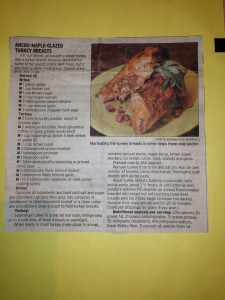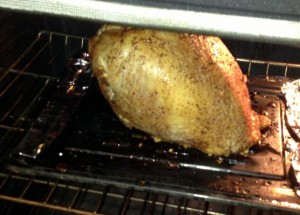getting back on the horse
Walk, Trot, Canter
We spent last weekend in College Station. Sam rode Trevor in the state Special Olympics, Class A. Here’s the ride. Trevor was really working hard, Sam said, but they didn’t medal.
I’ll post the trail and showmanship videos next.
Saturday night in the kitchen with Sam
Over the years we have made a true commitment to our family’s health by doing a lot of cooking and baking. Tonight, I’m making another batch of yogurt and Sam is making kolaches.
I had enough variety of leftover beans from a bunch of winter cooking to make a mixed-bean soup, too.
Over conversation about tablet computers, e-reader apps, and area equestrian Special Olympics (they moved it up to today instead of tomorrow … awesome flexibility demonstrated by area stables in order to avoid predicted storms), I put this old family favorite together, substituting in lamb stock for water at the end.
Bountiful Bean Soup
2 cups mixed beans
1 quart water
4 slices of bacon, diced
1 large carrot, sliced
1 clove garlic
1 bay leaf
6 cups water
Salt and pepper to taste
Bring beans and first quart of water to a boil. Cover and let stand for an hour. Drain and rinse a little. (This helps reduce your need for Bean-o)
Fry bacon in a dutch oven and discard all but 2 t. of the rendered fat. (Or, leave out the bacon and heat 2 T. of olive oil.)
Add the carrot and garlic and saute for a few minutes to carmelize, then add beans and water and bay leaf. Bring to a boil and then reduce to a simmer, cooking for 90 minutes or so until the beans are tender.
Remove bay leaf, taste and add salt and pepper to taste.
Overheard in the Wolfe House #266
Peggy (looking at Sam’s frazzled face): So you had a rough day, too?
Sam: Yes. But at least I got something done at horseback riding.
See Sam Drive: Lost in mid-cities
If I ever doubted that no good deed goes unpunished, the lesson was reinforced today.
Michael had a job interview and asked to borrow the truck, since the air conditioning is out in his car.
(This is February, you say. This is Texas, I tell you.)
So out of his routine was he, that when he returned to the truck after the interview, he realized he locked the key inside. He called to ask whether there was a hide-a-key.
(No, son, a hide-a-key is something parents make their kids do with their own car.)
He didn’t want to pay for a locksmith if Sam could come with a spare. There was time. Sam loaded directions in the GPS on his phone and headed out.
Sam is not a fan of I-35. E or W. He took State Highway 114 and headed south on Precinct Line Road to where Michael was, in North Richland Hills. That was probably a mistake. Maybe U.S. Highway 377 would have been better. He got lost somewhere in Keller — so lost that he pulled over and called police to get help. They came and gave him directions.
Sam made it to the parking lot where Michael was waiting and the two of them were supposed to follow each other to I-820, where they would part ways at I-35W.
I thought all was well and then Michael called me again.
“I lost him,” he said.
Every parent of a child with autism knows this terror. And now his brother was learning it, too. Michael recounted as much of the situation as he could, starting with the moment he realized Sam was heading down State Highway 183 the wrong way, and I was at a loss of what to suggest next.
Sam had turned his phone off to save battery life. That worried us both. Not only was he not communicating with us, we knew “Siri” wasn’t giving him directions home.
“Call the police. Make a report,” I told him. “We can’t do this. We need the village.”
A co-worker (one of several that talked me off the ledge today) offered to take me home and Shahla provided a bit of support via text. Meanwhile, Michael was making a report with the police. I so hoped that Sam would be parked in the driveway when I got home, but he wasn’t.
I put an alert on Facebook and started to regroup. I would take Michael’s car and meet him and the police in North Richland Hills where they were making a missing persons report. (Because Sam has autism, it would have gone out immediately.)
And then Sam came down the driveway. I called Michael. The police shredded the missing persons report Michael had just signed.
It took awhile for the emotions to settle and the conversation to begin. Sam knew he had separated from Michael and had been going the wrong way down the highway. But he remembered the directions Michael gave and when he was sure things weren’t looking right, he turned around and went the other way. He stopped at a medical center to get directions, too, and then he headed home.
(So, Tim Ruggiero, not only pizza places, but also medical centers are good places to get directions, we learned today.)
We gave ourselves a list of things to do, like Michael joining AAA, and Sam putting GPS in his car with a “home” button, and me putting a hide-a-key on the truck, so that all our good deeds trying to help each other out don’t get so punishing.
And, a big shout-out to all of the mid-cities’ finest. You got to know autism today and you did well.
Overheard in the Wolfe House #262
Sam: Mom, I’m very relieved to be home.
Peggy: I’m relieved to have you home.
[No hug; END scene]
And the trail ride
Sam loaded this video to his own YouTube channel. Michael shot it, and you can hear him at one point chiding the horse, Trevor, who didn’t appear to cooperate at the gate.
Tonight Sam talked about this ride in a way that he hadn’t shared before. I had walked by him sitting in the recliner on my way to my own chair in the living room and gave his knee a pat.
This is something that typically makes him recoil from my touch, so I rarely do it, but I try from time to time. He recoiled, of course.
But after doing so, he told me that he had strong reflexes and that it can be a problem when riding horse. He said that he has to try to control them, otherwise his body sends the horse the wrong signal of what he wants to do.
“Like when we were at the gate,” he said.
Excellence on horseback and that 10,000 hours expert thing
Sam competed again in Chisholm Challenge this year, and he earned another belt buckle for his English equitation ride, his sixth in about 10 years.
I started thinking about Malcolm Gladwell’s book, Outliers, and this concept of how long it takes to become an expert at a thing.
Sam looks like an expert on horseback to me. See for yourself (brother Michael is the videographer):
Michael says that when Terry Evans interviewed Sam and him for this piece in the Fort Worth Star-Telegram, Evans was surprised that we didn’t own a horse even though we lived in Argyle. (Dude, it’s Aubrey where the horses outnumber the human population, but I digress.)
But I thought, I should count up the hours he’s been riding. Maybe he comes close to that magic number in Gladwell’s book at one hour per week, and about 40 weeks per year, over 21 years …
840 hours – not even in the ballpark and couldn’t even get close in 40 more years of riding. But I’m sure he’ll have a blast trying.
Adaptation
A friend warned us after Dixie was diagnosed with diabetes one month ago that she would go blind. I wish I’d known how fast that would come. She already had cataracts going into this (an early sign, perhaps) and last week, before the ice storm, she got an infection in one eye.
By the weekend, her vision was completely gone.
I saw my home in a new way. It is not, by any stretch, an age-in-place kind of abode. But I downloaded a primer with 65 tips on how to help a dog that has gone blind. We’re doing what we can.
What’s been tough for Dixie is the speed of the loss. She hasn’t had a lot of time to adapt, the way you might if your vision slowly fades from aging. The ice storm didn’t help either. She has the most confidence when we get the leash and go for a walk outside, but the ice is cruel. It hides important clues under the feet and yields unexpectedly.
The storm allowed me time to observe her closely and make changes we needed to make quickly and speed her adaptation. But, for a few days, I also watched her wake up each morning, and from naps, having forgotten for a brief moment that she was blind.
Just like other December mornings some years ago, when I woke up each morning not remembering, for one or two glorious seconds, that Mark was gone.
Ways with bird
About this time every year, Mark and I would be negotiating over the spot where the turkey fryer would go. When the boys were younger, he often deployed it those evenings we made venison burgers on the grill and we needed to make as many French fries as a fast food restaurant fryer holds. That turkey fryer helped feed those boys with hollow legs. If Mark kept it close to the grill to manage the job as I worked in the kitchen on the rest of the meal, that was fine with me.
But the second or third year we made a fried turkey in it, Mark splashed. If he hadn’t been so swift at turning off the gas, we would have had a real problem. And by that I simply mean meat too randomly charred for consumption even by Wolfe family standards.
The incident didn’t phase my slightly pyromaniac husband. But I still reminded him each year that this wasn’t the way to share Thanksgiving dinner with the good folks of Emergency Services District No. 1 and it might be best to move that fryer just a little further away from the garage.
After Mark died, I gave the turkey fryer to my sister and brother-in-law, who raised two professional firefighters. They use it a lot for shrimp boils. And, I went back to this collection of Thanksgiving dinner recipes I started when the Fort Worth Star-Telegram would talk a local chef into helping a hapless reader — usually someone who barely cooked at all — develop a menu and practice it once before the big day.
I always admired the many ways those chefs could come up with a way to roast turkey. But I was collecting recipes for the sides and desserts to go with that big fried bird. The first year I made the pepita brittle, it almost didn’t make it to the table for its intended purpose garnishing the pumpkin flan. The soups were marvelous. And so many inventive ways to serve the cranberries. It’s a nice collection.
After a few years without our turkey frying guy, the kids and I appear to have settled on a favorite way to roast that big bird, a recipe that uses just the breast. Tonight, it just occurred to me why it may have become the favorite. Here’s the recipe for a hint:
The house is filled with the smells of smoky chile and maple. Texas plus Wisconsin. They go good together.
Always a reporter, never a source (except maybe once)
For about six months in 1997, this tapestry lay over the table in the breakfast room at our house as we worked with two other couples and a high school student to turn it from bits of amazing fabric to the beautiful design you see here.
It is one of the five large tapestries that hangs during the Easter season at our church, St. Philip the Apostle Catholic Church in Lewisville. Three are conceived as panels in the main display, two more flank the sanctuary, and a sixth, smaller tapestry drapes over the altar.
For Easter season alone, we had to have enough volunteers to make the six tapestries. Multiply that by the many seasons of the church calendar — the bold red tapestries for Ascension and Pentecost (Sam’s favorites) hang for just two weeks — and you get the sense of what a barn-raising that was.
Mark announced in 1996 that he wanted to convert, something apparently he had been quietly thinking about for years. In the early 1990s, we’d found a good church home in Sacramento, at St. Francis, during, of all things, the time when they were retrofitting the sanctuary for earthquakes and Mass was being held in the school gym. Mark said he hadn’t known such a spiritual home when he was growing up, which always made me a little sad. I know there were times as a child I didn’t get what church was about, but there were times that I did.
The first year after Mark died, I came to help switch out the tapestries between Lent and Easter. There was a team of volunteers who did it regularly and they welcomed me. Once they knew I was part of the team that stitched it together, I got peppered with questions, as if they were historians that had just stumbled upon the best primary source ever.
They had a burning question. Was is true, that one of the Easter tapestries had a bit of a parishioner’s wedding dress on it?
Yes, I said, pointing to the tapestry that we had made.
Now, don’t get excited, dear Internet people, it wasn’t a piece of my wedding dress. Mark and I were such hipsters back in the day, I made our get-married-barefoot-on-the-beach-in-Kona clothes of a buttery linen. This tapestry is filled with bridal fabrics, but full of shiny silks and satins and sparkly lames and organzas.
Two Dominican nuns designed the work and set up all the volunteers with the patterns and fabrics needed. They included a little extra for errors.
Our team didn’t quite cut all the fabric at once, which we maybe should have, but we were also worried about losing track of some pieces. By the time we came to the very last piece, there wasn’t quite enough of the creamy white, rich brocade the sisters intended. We nearly panicked. No matter which way we turned the piece of remaining fabric and pattern, we couldn’t make it work.
Marcy, one of the volunteers, studied it closely. “It looks like my wedding dress. I bet I have enough fabric left,” she said. We were stunned when she brought the piece the next week. It was almost a dead ringer for what the sisters had given us to use.
We decided to sew it on and tell the sisters later. They thought it was a great solution, but the story still turned into church folklore. As my friend, Donna Fielder says, now that I am too old to die young, I see that’s what people do with certain stories.
Each Easter season, I get a little misty when I see this tapestry, knowing that Mark’s signature is on the back with mine and that of our friends and knowing the year the tapestry was started was the year he was welcomed into the church.




